by Kevin Winter, University of Cape Town
This is an exciting study that is starting to yield significant results in the use of nature-based processes to treat surface water runoff from an informal settlement and to safely reuse the water to irrigate vegetables. In many parts of Africa, poor water quality is used to irrigate vegetables without any form of treatment. The University of Cape Town is working on a research and development site that is ideally situated to improve our understanding of how nature cleans and treats water. The site is less than 1 km away from an informal settlement and a poor housing estate with over 7000 inhabitants, most of whom are unemployed and rely solely on government grants. Informal settlements in South Africa are places that epitomize significant social and economic inequalities in the country. Inequality is largely a legacy of the Apartheid system and this legacy continues to manifest itself in a post-democratic period in one of the most unequal countries as measured by a Gini-coefficient of 0.67 (Díaz Pabón et al., 2021). Despite government interventions to accelerate development in providing social housing, and other interventions, nearly 1.4 million households, or approximately 3.6 million people, are living in informal settlements with limited access to basic services of water, sanitation, electricity and solid waste. Most often, in the absence of formal sewerage systems, residents choose to construct makeshift stormwater drainage channels as conduits to dispose of their unwanted water. Runoff from discarded greywater is often combined with blackwater from leaking and poorly maintained communal toilets included water that is tossed from toilet buckets, from open defecation sites and contaminated further from solid waste. Without proper treatment, contaminated surface water runoff poses a significant threat to the receiving freshwater bodies resulting in a risk to human and environmental health.
The work represents one of the first research studies on the use of nature-based systems to treat surface water runoff from an informal settlement without using chemicals. In START’s previous quarterly newsletter, we briefly described the site and research activities. Here we briefly report on some results, risk assessment and progress toward a Circular Economy.
Why Biofilters?
Biofiltration systems, hereafter referred to as biofilters, represent one of the most promising nature-based solutions (NBS) for removing environmental pollutants. Studies have shown that biofilters can reduce or remove organic and inorganic matter, as well as nutrients and pathogens like natural wetlands. It is surprising how little we know about how natural wetlands function and their ability to perform a range of function including sedimentation, filtration, chemical precipitation and adsorption, microbial interactions, and uptake by vegetation. The benefits of using nature-based systems to improve water quality are widely reported in the literature, however, in South Africa, these kinds of solutions are in their early stages of implementation. There is uncertainty about the efficacy of nature-based solutions or sustainable urban drainage systems (SUDs) in mitigating the impacts of surface water discharge in treating surface runoff from informal settlements. There is limited research on the extent to which these systems can meet water quality targets from runoff that is generated in informal settlements and how NBS can meet the requirements for safely irrigating food gardens.
Study site
The research takes place at a study site known as the Water Hub which was established in 2017 on an abandoned wastewater treatment plant about 3 kilometres west of the formal town of Franschhoek. Less than 800 meters above the site is a low-cost housing estate and large informal settlement. The Water Hub is approximately 65km east of Cape Town (CBD) and is situated in a Mediterranean climate region with a seasonal precipitation, and warm, dry summers and cool, wet winters.
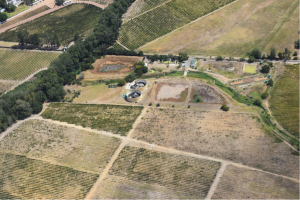
Biofilters at the Water Hub
The Water Hub is a research and development initiative that began in 2017 with seed funding from the Western Cape government and in partnership with the Stellenbosch Municipality who are the landowners. In the first phase of project, six existing wastewater sludge drying beds were re-designed and converted into biofiltration cells. Each cell measured 16 m in length, 3 m wide and 0.63 m in depth. The physical structure of the existing drying beds was repaired and then lined with a 5 mm thick low-density polyethylene (LDPE) material. Each cell was packed with a natural media of either large stone aggregates (19-25 mm diameter), small stone aggregates (7-9 mm diameter) or peach pips, the latter being acquired from the fruit processing industry in the region and chosen as a carbon source (Figure 2).
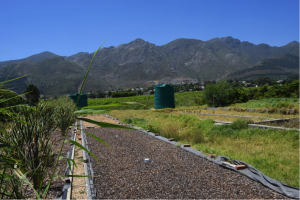
Results from treatment
Biofilters typically use vegetation, natural filter media (soil, gravels, crushed rock, sand) and associated microbial assemblages to clean contaminated water. Some research claims that the filtration media is most important because it controls the physical removal (filtration, sedimentation), chemical removal (adsorption) and biological removal (microbial decay) of pollutants. Other studies show that vegetation is more important because it promotes pollutant removal through phytoremediation and evapotranspiration. However, it does depend on the target pollutant in question. In this report, we briefly focus attention on the removal of phosphorus (P) and nitrogen (N) and as the main target pollutants.
We use orthophosphate as an indicator of P. Figure 1 shows the results of bi-monthly data collection at different periods over the last 3 years of the study. A series of boxplots shows how the concentration from the influent water (water fed directly from the contaminated river that intercepts surface water runoff the informal settlement) changes after 7 to 14 days of retention time in each biofilter. The results show that large stones performed best in capturing P and reduced concentration of P by 70% (Large Stones) and 78% (Large Stones Vegetated). A Wilcoxon statistical test shows that the difference between the influent and discharge from the large stone cells is statistically significant (p value 0.000). The average concentration of P from the large stone vegetated cells is less than 0.5 mg/l which is considered safe for irrigation and unlikely to harm the soil. The other cells show mixed results and often an accumulation of P.
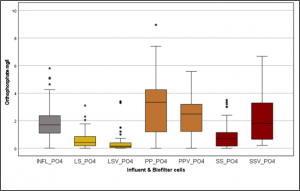
Another nutrient of interest is Ammonia-Nitrogen (NH3-N). Using the same colour codes as in the previous figure, the influent and biofilters show the reduction of NH3-N in Figure 2. Here the reduction is the result of denitrification caused by bacteria and microbial communities that are lying deep within the biofilters. Notice that the large stone cells perform best of all by reducing NH3-N concentration by 80% (LS) and 87% (LSV), with average concentrations ranging between 1.6 and 2.5 mg/l. Over time, based on evidence from recent data analysis, the performance of all the cells improved because of an increase in bacteria and biofilm that forms around the surfaces of the packing media.
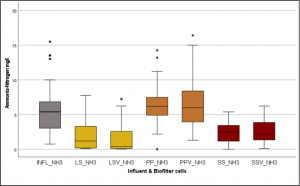
Implications: transitioning to a Circular Economy
Thus far the study has identified the best performing biofilter media. The reduction in nutrient levels is statistically significant. The treatment is capable of reducing concentrations to fall within the safety margins for irrigation and soil care. Obviously, this will need to be monitored carefully to determine, for example, any build-up of salination (salts in the soil). The vegetables are receiving a mild fertilisation from nutrients in the irrigation water which improves the rate of grow and yield, but high concentrations of nutrients will cause crop stress and potential risk to human health if indigested at levels that could be carcinogenic.
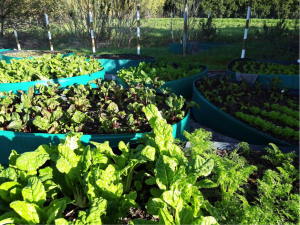
Food security in a water stressed region and in an area of urban poverty offers a variety of opportunities and benefits to local residents. The pictogram below shows an overview of what is being achieved and is envisioned by recovering resources from treated water, including the use of non-renewable energy to pump water for irrigation and the involvement of community in food production. The social challenge is to build a small enterprise that involves a small community group who are willing to participate in growing food and finding a market for the products. The idea of the FEW nexus (Food-Energy-Water) is to improve the use of resources by recovering and reusing waste. Once the nexus is more integrated with a Circular Economy it opens up further opportunities for introducing organic and other wastes to the site which can add further value such as producing high-quality composts and soils.
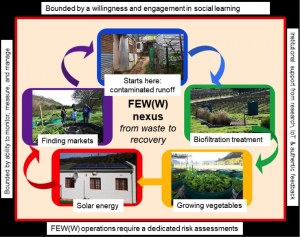
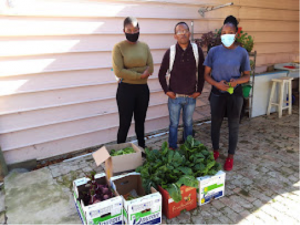
We gratefully acknowledge the support of START for the support in this research and the application of the project to community-building.


